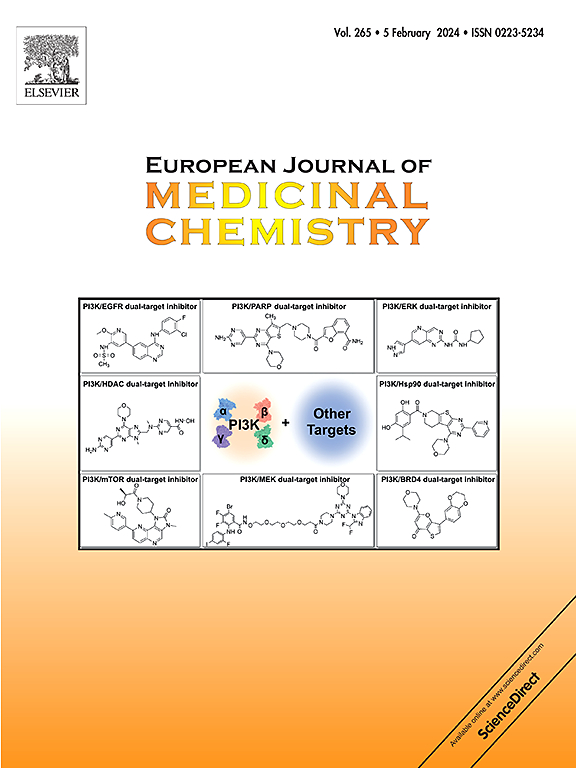Molecular and supramolecular routes to enhance Gadolinium-based contrast agents relaxivity: How far are we from the theoretical optimal value?
IF 6
2区 医学
Q1 CHEMISTRY, MEDICINAL
引用次数: 0
Abstract
Gadolinium Based Contrast Agents (GBCAs) are routinely used in the clinical practice to enhance the diagnostic potential of MRI. Their contrast enhancing capabilities rely on their ability to increase the relaxation rate of tissue water protons. This property is expressed by the relaxivity, whose value is determined by structural, electronic and dynamic characteristics of the GBCA. Based on extensive experimental work over the past four decades and the well-established theory of paramagnetic relaxation, it is usually possible to correlate observed relaxivity values to specific molecular properties. Key determinants include the number of water molecules and/or exchangeable protons in the first and second coordination spheres, their distance from the paramagnetic Gd3+ ion, the ion's electronic relaxation time, molecular reorientation time, and the exchange rate of the coordinated water molecules. Understanding the key factors that affect relaxivity has enabled the design of systems with optimized structural and dynamic properties. However, some examples demonstrate exceptional relaxivity which cannot be fully explained by the established theory. In particular, GBCAs within confined environments show significant promise for developing high-relaxivity agents. Overall, one may state that nowadays it is possible to attain highly efficient GBCAs thanks to the in-depth understanding of the structural and dynamic determinants of their relaxivity, together with the optimization of their in vivo stability and biodistribution/excretion properties. This knowledge is crucial for the rational design of the next generation of MRI CAs. The domain of Molecular Imaging will also largely benefit from these efforts.


增强钆基造影剂弛豫的分子和超分子途径:我们离理论最优值还有多远?
钆基造影剂(GBCA)是临床上常规使用的造影剂,可增强核磁共振成像的诊断潜力。钆基造影剂的对比增强能力取决于其提高组织水质子弛豫速率的能力。这种特性用弛豫度表示,其值由 GBCA 的结构、电子和动态特性决定。根据过去四十年的大量实验工作和成熟的顺磁弛豫理论,通常可以将观察到的弛豫值与特定的分子特性联系起来。关键的决定因素包括第一和第二配位球中水分子和/或可交换质子的数量、它们与顺磁 Gd3+ 离子的距离、离子的电子弛豫时间、分子重新定向时间以及配位水分子的交换速率。了解了影响弛豫性的关键因素,就能设计出具有优化结构和动态特性的系统。然而,一些实例显示出的特殊弛豫性无法用既定理论完全解释。特别是,在封闭环境中的 GBCAs 显示出开发高弛豫剂的巨大前景。总之,我们可以说,由于深入了解了弛豫性的结构和动态决定因素,并优化了其体内稳定性和生物分布/释放特性,如今我们有可能获得高效的 GBCAs。这些知识对于合理设计下一代磁共振成像 CA 至关重要。分子成像领域也将在很大程度上受益于这些努力。
本文章由计算机程序翻译,如有差异,请以英文原文为准。
求助全文
约1分钟内获得全文
求助全文
来源期刊
CiteScore
11.70
自引率
9.00%
发文量
863
审稿时长
29 days
期刊介绍:
The European Journal of Medicinal Chemistry is a global journal that publishes studies on all aspects of medicinal chemistry. It provides a medium for publication of original papers and also welcomes critical review papers.
A typical paper would report on the organic synthesis, characterization and pharmacological evaluation of compounds. Other topics of interest are drug design, QSAR, molecular modeling, drug-receptor interactions, molecular aspects of drug metabolism, prodrug synthesis and drug targeting. The journal expects manuscripts to present the rational for a study, provide insight into the design of compounds or understanding of mechanism, or clarify the targets.

 求助内容:
求助内容: 应助结果提醒方式:
应助结果提醒方式:


